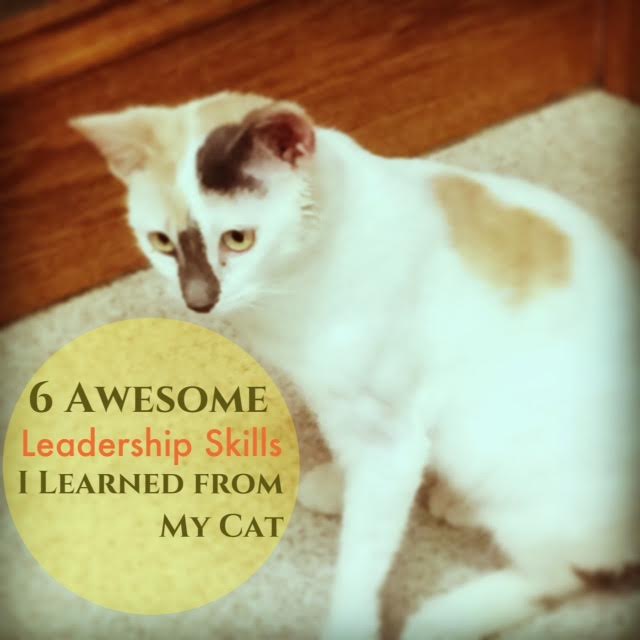I am in pursuit of a graduate certificate in social media marketing. As part of the program, I was develop a brand and blog that I was to consistently update over the coarse of a semester. The semester has now ended and to those of you who found your way to this site and encouraged my progress through followships and comments, I now invite you to stop by official website and blog at www.vncimageandleadership.com. You will find posts from this project as well as new ones and get more of an understanding of the purpose of my online presence. Thank you so much for your support here and I look forward to connecting with you there.
Everyone is a leader.
Everyone has the potential to be a
leader.
My cat, Kipsy, has my respect. In fact, most cats have my respect. There’s a lot we can learn from the feline world that can help us to become better leaders. Here are some of the skills I learned from my cat:
1. My cat has clear boundaries
There are certain times that I can interact with my cat and times when I can’t. These moments are completely determined by her. If she is receptive to cuddles or petting she will purr and rub her face against my ankles to signify it is okay to touch her. If it is not a good time to show affection, she will nip or bat at me to let me know this is her “me” time. There are times in the “people” world where we need to do the same. We have to let others know what our boundaries are so we can learn how to best work with each other. This will ensure we don’t end up pushing each other too far past those boundaries.
2. My cat is self-sufficient
I need not worry about my cat most of the time. She lives by her own clock and routine. I make sure she has fresh food and water and a clean litter box and she fills in the blanks. I’m not taxed with making sure she gets out for a walk and she doesn’t tear the house apart while I’m away. She initiates her own tasks based on her needs. Showing that kind of initiative is valued in a work environment as well. Understanding your job description and using the tools that you are given, go about your day initiating and completely tasks. Don’t rely on your supervisor or co-workers to tell you what to do next. Be self-sufficient.

3. My cat keeps herself groomed
Cats, in general, are good groomers. If I pet my cat, she will almost immediately plop herself down to clean the spot where I ran my hand over her. I feel she takes pride in her appearance. This is a good example for us to follow too. Trimming, clipping, showering and ironing are important habits that should be a part of your daily routine. Your appearance not only says something about you as an individual but can say something about the company you are employed with too.

4. She knows how to get attention
Kipsy knows that being in the right place at the right time is important for getting what she wants. That usually means lying across my keyboard or sitting on the paperwork that I am trying to finish. Using her voice will also indicate to me that I need to take heed of what she is trying to communicate. These same skills are essential for leadership. Knowing how to get people to pay attention will help in delegating, brainstorming and obtaining feedback.
5. She lands on her feet
Of course, I am being literal here. If my cat falls or is dropped (accidentally of course :)), no matter what position, she will always land on her feet. Figuratively, leaders strive to land on their feet as well. When faced with adversity, leaders need to be quick to troubleshoot the best way to come out of a crisis so they too, “land on their feet”and can stand strong.

6. She isn’t afraid to try something new or explore
Kipsy is always roaming around to find new things to play with or items to explore. She doesn’t seem to be afraid to stick her head into a dark box or sniff at a new object that has been introduced. She is tentative and uses calculated caution when broaching something that she’s never encountered before. Nonetheless, she simply must check it out. Risk-taking is a beneficial trait of an effective leader too. Exploring a new concept or product can blaze a trail of innovation and create new possibilities. Kipsy has found some great lounging spots that I would have never expected because of her desire to explore.
Are there other cat traits that you can think of that lend themselves to a leader’s resume? Or perhaps there is another animal out there that also demonstrates abilities that we could learn from?
Should you or shouldn’t you chew gum in a working environment? Here a couple of thoughts to consider:
This is a post I wrote back in 2011 on vncimageandetiquette.com:
When I was first making the transition from high school to university (many years ago now), I signed up for a summer “warm-up” program to help ease the anxiety of moving to the next stage in my life. One of the workshops I attended was an overview of what to expect in a university class versus a high school class. There were some valuable tips I picked up in the seminar that helped me survive as a student and I wonder what would have happened if I didn’t take it. How did the other students make it if they didn’t attend that seminar like I did? Many of those tips have stuck with me and I still practice them when attending professional development workshops and classes. Here are some:
Go to Class
For many, post-secondary is the first time living away from home or expected to fend for one self. Being regarded as an adult and expected to make decisions for oneself can be very exciting. But choosing to party all night and skip class the next day can be a costly mistake. It’s difficult to absorb information and get to know your classmates and instructors if you don’t make it to class. Often, instructors will put questions on exams that pertain only to notes and discussions they hold in class.
Go to Class Early
There are a few reasons why this an important one. Firstly, if you are early then you will have time to go over notes and feel prepared for the lecture. Secondly, you can strike up a conversation with your instructor to reinforce understanding of class content and ask questions. Lastly, even if you do not stand out as an early bird, it is better than standing out as a late-comer.
Sit close to the front
As a student who often elected to sit at the back during high school, I realized a huge difference in my marks when I started to sit at the front. I was less likely to be distracted since I was in proximity to the instructor. I could hear better, see better and participate more when I wasn’t separated by several rows of students. I also didn’t have any students to hide behind so I was more likely to stay engaged since the instructor could see me.
Make eye contact with your instructor
You will find when you make eye contact with the instructor and gesture that you are genuinely listening to what he/she has to say, they will start to look to you for clues of understanding. This will help you build rapport with him/her and you will probably find you are more engaged when that happens. It will also make it more comfortable for you to ask questions or approach him or her at another time should you have questions or need assistance.
Be prepared
Do your homework and readings. This will allow you to be engaged during class and contribute to discussions. You’d be surprised how much easier it is to pay attention when you understand what is being presented. If you don’t understand, you will feel more confident to ask questions if you have at least attempted to read or understand the homework. You will also find it far easier to build a relationship with your instructor when you show him/her that you are putting in the effort.
Participate
Nothing makes an instructor happier than when s/he has a student who participates in class. Ask questions and start discussions. This is when the real learning takes place. When you start a discussion, you not only let the instructor know that you have been doing the readings, but you are able to engage other learners and learn from them and their perspectives. Not-to-mention, this will help to reinforce the concepts learned from class and homework.
Be respectful
The classroom is not the place to snooze, text, listen to your favourite tunes on your iPod, change your Facebook status or tell the person next to you how great the party was on the weekend while the instructor is talking. Some instructors may allow time for such activities but don’t take advantage. Remember, you are there to learn and so is everyone else.
Can you add any other success tips that help(ed) you as a student?
Great leaders know who they are. They know their strengths, weaknesses, preferences and capabilities. If I asked a leader what his/her greatest accomplishment was, he/she would be able to answer me almost instantaneously. He/She would be able to do this because s/he spent time considering such things about himself/herself. It could be because s/he practices intraspection (the act of self-examination or reflection according to FreeFactFinder.com) or perhaps she/he takes self-assessments or questionnaires regularly. It may even be because he/she makes a habit of asking others for input on things that are noticed about him/her.
It may sound simple to think about what you know about yourself because surely no one knows you better than you. Let me ask you:
What’s your greatest accomplishment?
What’s your greatest weakness?
What are your top 3 strengths?
How would you describe yourself?
How would your closest friends describe you?
If you can answer these questions with relative ease, you probably spend some time paying attention to your inner dialogue and desires. If it is taking you more than a minute to come up with answers or if you have no idea how to answer them, it’s time to dive into the inner recesses of your self to bring these details to the surface.
Knowing yourself opens doors to so much potential. It gives you a better sense of career direction, it helps you to understand how to work with others and let’s face it: it’s much easier to answer the tough interview questions when you have a strong grasp on what makes you tick.
If you’re curious where to begin the journey of inner-self discovery, I have some links to get you started. My personal favourite is the Keirsey Temperament Sorter for personality exploration. If you are familiar with the Myers-Briggs Type Indicator, it’s based on the same theory and although it is not as in-depth it does give a good indication of key personality preferences. I must give credit to a friend-in-blogging, Jason (aka dadhackblog.wordpress.com), for compiling many of these other great links:
Values: My Plan – Career Assessments
Personality: The Keirsay Temperament Sorter; Type focus – Self Awareness
Essential Skills: Government of Canada – Tools, Assessments and Training Support
Learning Styles: Education Planner Learning Assessment
Interests: Your Free Career Test
Work Preferences: CareerPerfect.com
Next Steps: nextsteps.com
In my career world, there is a person that has a reputation of being tough. She’s a super power with a lot of clout and extremely intimidating. Everyone in my career circles dreads crossing into her presence. One day, I was directed to set up an appointment with her to go over new strategies. <insert dramatic music here> Stress kicked in for horror stories developed as I pictured myself being reduced to tears by the mere look from her piercing eyes. This called for the <duhn! duhn! duhn! (dramatic rift)> Power Suit.
A Power Suit is the outfit that makes you feel like you can run the world. It’s almost like a costume and changes you into the character that you want to portray for the situation you are embarking on. It will have the following characteristics:
It flatters you:
The power suit will fit to the curves you want to accentuate and detract from the ones you don’t. The colours will be suited to your seasonal palette so your eyes glimmer and your skin glows. It makes you feel good.
It fits your career:
Your power suit is meant to give you confidence in the career world. Interviews, meetings, speaking engagements or networking. It should be reflective of the career you are in or are striving for. A Sith uniform or Jedi Robe is only a suitable Power Suit if working with the “The Force”.
It gives you authority:
Because it flatters you and you will feel good wearing it, you’ll walk a bit taller. This will present a professional image and people will give you the credibility you deserve.
It is stylish:
Depending on your personality, it may be trendy or it may be classic. Either way, you have chosen that outfit because it speaks to who you are and is well put-together. The message that style sends is that you put thought into your choice of wardrobe.
It is current:
If you are more of a classic dresser, your power suit from 10 years may still serve its purpose since classic looks tend to be timeless. It’s worth getting some opinions on how your outfit has held up over time if you intend to wear something with some date to it. That aubergine ensemble that you just love may not give the same impression today as it did in 2005.
Describe your “Power suit” if you have one. Any suggestions where one might find a “Power Suit”?
Mass mailing or emailing an unsolicited resume to any employer one thinks may have a position, isn’t an effective job search. Here are some examples why…





Recent Comments